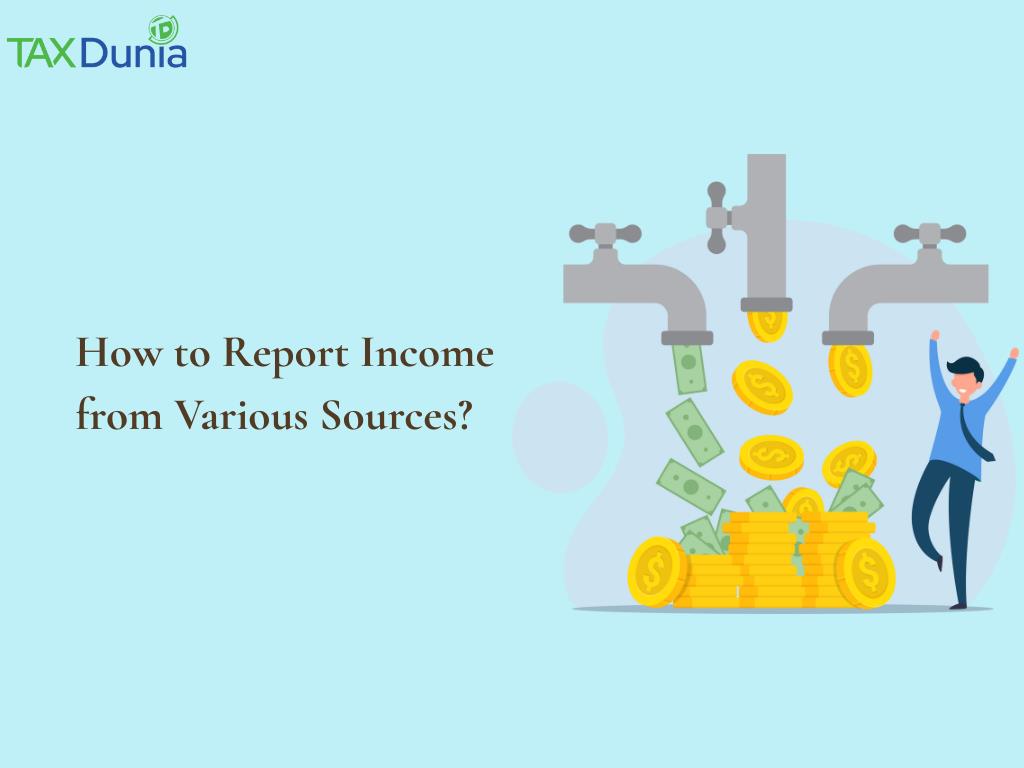Under the Income Tax Act of 1961, taxpayers can file their income under five heads. Based on the source of income and total amount, the tax authorities decide the applicable tax rate on the payer. The five heads of income are: income from salary, house property, capital gains, profits and gains from business and profession, and other sources. The first four heads represent their name, but the last head, other sources, is quite wide and inclusive. There are some essential steps for reporting income from various sources. You can learn about these steps so that you ensure meeting compliance and liabilities.
Table of Contents
What are the Various Sources of Income under the Income Tax Act?
The five heads under income tax are distinctive and project details by their name. Still, taxpayers should have information about the heads so that the chances of making mistakes could be reduced.
- Income from Salary
Income received as remuneration in exchange for services rendered comes under the salary head. This includes income from salary, allowances, bonuses, and other benefits attached to employment. The basic components of salary are such as
- Basic salary: the fixed portion of salary that forms the main part of income
- Allowances: additional benefits such as HRA, DA, and travel allowances are also part of the salary income
- Perquisites: extra benefits like rent-free accommodation, the employer provides a car, etc., in addition to salary and allowances
- Deductions: Provident fund contributions, professional tax, and TDS make up part of it
Income coming from renting a property, whether residential or commercial, comes under the head of income from house property of the Income Tax Act 1961. A house property can be the person’s home, office, shop, or building, or some land, generating income. The house property could be a let-out or self-occupied property.
- Income from Capital Gains
Income from capital gains refers to the profits a person makes from holding a capital asset for a particular period. It is classified into two categories, namely, short-term capital gains and long-term capital gains. The following are some examples of capital assets; therefore, gains made out of selling these assets for holding for a timeframe are considered Income from Capital Gains for tax purposes
- Tangible capital assets like land, buildings, machinery, vehicles, and equipment for the production or operational use of the business
- Non-physical assets like patents, copyrights, goodwill, IP rights, trademarks, etc.
- Fixed capital assets such as factories, warehouses, and office spaces
- Financial capital assets like stocks, bonds, mutual funds,
- Personal capital assets like residential property, jewellery, and personal vehicles
- Income from PGBP
The income from “profits and gains from business and profession” (PGBP) is covered under Section 28 of the Income Tax Act. This section includes profits Income from Business & Profession from sales of goods or services. It also includes salary, commission, bonus that comes as reward. Compensation payments such as termination of employment or modification of contracts also come under this head along with other elements.
This head is the widest and most inclusive of all the other heads. The sources of income left out in all four heads come under this head of the Income Tax Act. Section 56 deals with the income from other sources head, and the following are some of the income sources that come under it
- Interest income
- Specific rental income
- Family pension
- Gifts and cash prizes
- Commission income
- Lottery and gambling winnings
- Earnings from digital platforms
- Income from lease
- Income from savings bonds
Essential Steps to Report Income from Various Sources
To report salary income
If you are reporting income from salary, you need to provide basic documents and other specific documents as well. For this income, you must provide Form 16 issued by the employer showing salary breakdown, tax, and Chapter VI-A deductions. Salary slips are optional, but helpful if you offer and rent receipts and Form 26AS showing TDS deducted and deposited against your PAN.
- Interest certificates from the bank and the post office
- AIS and TIS
- Details of investments and others, like tuition fees, hostel expenses, transport costs, etc.
To report house property
Ownership proof, like a property deed, registry, allotment letter, and the number of properties, must be presented. You also need to show rental income documents like rent agreement, rent receipts, proof of municipal taxes paid, and bank statements.
Reporting capital gains income
Provide the poofs of investments that you have made in equity shares, real estate, gold and jewellery, etc., giving out all these documents makes it easier for the tax authorities to keep a track record of investments. It sets out a clear record for you.
To report PGBP income
You need to give financial statements like profit and loss statement, balance sheet, audit report, AIS & TIS statements, advance tax challans, GSTR 1 and 3B if required. It makes the filing smooth, and you can proceed without hurdles.
To report income from other sources
As the head of income is as wide as one can be, documents vary based on the source. For example, for lottery winnings income, lottery ticket/receipts, bank statement, TDS certificate, and Form 16B are a must. For agricultural income, the sale receipts, land ownership documents, and Form 26AS are required. For dividend income, dividend warrants/statements, form 26AS, and demat account statements must be reported.
Get Started with TaxDunia
Reporting the right documents at the right time is one of the most essential steps for reporting income from various sources. Reaching out to a tax professional can also solve the problems as they will offer you customized approach to deal with your finance accordingly.



